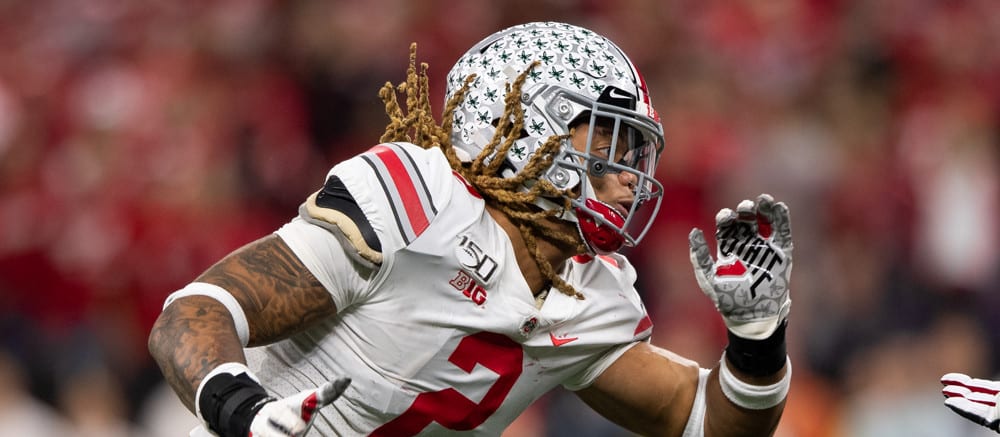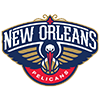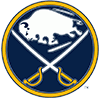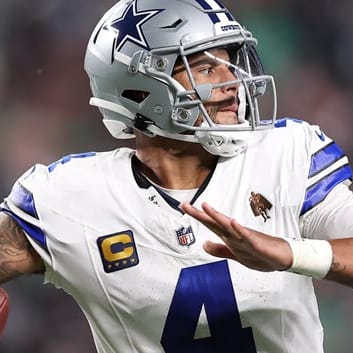Below are suggested rankings for the rookie IDP class of 2020. These should work for dynasty just as well as redraft.
Note: Players listed as the 'EDGE' subgroup within the defensive line category might be listed at linebacker and therefore might be ineligible at defensive line on certain sites. ESPN recently introduced the EDGE category – which ostensibly covers both defensive ends and 3-4 outside linebackers – so I'll include presumed EDGE-eligible players in the defensive line category.
I'll start with an overall list, but check the positional breakdowns for more details. Note, the overall list doesn't include the EDGE category.
1. Chase Young, DE, WAS
2. Kenneth Murray, ILB, LAC
3. Xavier McKinney, S, NYG
4. Logan Wilson, MLB, CIN
5. Isaiah Simmons, LB, ARI
6. Antoine Winfield Jr., S, TB
7. Patrick Queen, ILB, BAL
8. Willie Gay, LB, KC
9. Jordyn Brooks, OLB, SEA
10. Jeremy Chinn, S, CAR
11. Brandon Jones, S, MIA
12. Jacob Phillips, LB, CLE
13. Malik Harrison, ILB, BAL
14. Grant Delpit, S, CLE
15. K'Von Wallace, S, PHI
16. Javon Kinlaw, DT, SF
17. Derrick Brown, DT, CAR
18. K'Lavon Chaisson, DE, JAX
19. Julian Okwara, DE, DET
20. Davion Taylor, OLB, PHI
21. Zack Baun, OLB, NO
22. Akeem Davis-Gaither, OLB, CIN
23. Mykal Walker, OLB, ATL
24. Kenny Robinson, S, CAR
25. Ashtyn Davis, S, NYJ
DEFENSIVE LINE
1. Chase Young, DE, WAS (1st round, 2nd overall)
With Washington switching to a 4-3 defense, Young should be eligible at defensive end on all sites. As much as Montez Sweat and Ryan Kerrigan will both get their share of reps, Young is a rare breed and could be better than both right away. The Washington front four is built to apply immediate, top-grade pressure.
2. Yetur Gross-Matos, EDGE, CAR (2nd round, 38th overall)
Gross-Matos (6-5, 266) might classify as an OLB in Carolina, so he might mostly be DL-eligible on ESPN. YGM reminds me of Chandler Jones – the combination of extreme reach with plus explosiveness is the sort of stuff you generally only see from prospects like Jones and Aldon Smith. With 35 TFLs over his last 25 games, I find YGM more convincing than most. Unfortunately, even if he's very good, the Penn State product would likely struggle to provide IDP utility from the linebacker classification.
3. Javon Kinlaw, DT, SF (1st round, 14th overall)
Although he generally profiles as a space-eater more than a disruptor, Kinlaw (6-5, 324) could suddenly look more disruptive with the 49ers after drawing a lot of blocking attention at South Carolina. The defense around Kinlaw is the primary reason I rank him ahead of fellow tackle Derrick Brown. Neither Kinlaw nor Brown project as stat accumulators, so as a tiebreaker I'm deferring to the player on the defense that projects for more sacks.
4. Derrick Brown, DT, CAR (1st round, 7th overall)
Brown (6-5, 326) was more disruptive at Auburn than Kinlaw was at South Carolina, so I wouldn't argue against someone ranking Brown higher between the two. Pertinently, the Panthers defense projects to log more snaps than the 49ers one – the Panthers defense averaged roughly five more snaps per game than the 49ers last year – so Brown could theoretically have better access to tackle production. I just think Brown has less access to sacks, and he might see a lot of double teams in the run game.
5. Anfernee Jennings, EDGE, NE (3rd round, 87th overall)
ESPN lists Jennings (6-2, 256) as EDGE eligible but lists second-round linebacker selection Josh Uche as only LB-eligible. If anything this seems backward to me – Jennings is mostly a linebacker in theory, while Uche is mostly an edge rusher in theory. Anyway, Jennings at EDGE could be a major loophole to exploit in ESPN's scoring, as soon as 2020. Because Jennings figures to play linebacker, the Alabama product could post the highest tackle total of anyone on this list, even if he's only playing part-time. Something like 60 tackles on 600 snaps would put him in the DL1 conversation in a lot of leagues.
6. Jabari Zuniga, EDGE, NYJ (3rd round, 79th overall)
I think Zuniga's objective prospect profile is as good as that of K'Lavon Chaisson, who went to Jacksonville in the first round. Zuniga (6-3, 264) was productive at Florida, serving as a four-year starter with 34.5 tackles for loss in 42 career games, and he showed above average athleticism with a 4.64-second 40 and 127-inch broad jump. Zuniga compares trait-wise to someone like Melvin Ingram.
7. K'Lavon Chaisson, DE, JAX (1st round, 20th overall)
Chaisson (6-3, 254) was selected much sooner out of LSU than Zuniga was out of Florida, so it's reasonable to rank Chaisson higher than this. I just worry that he's not in position for immediate production, and I think the upside theory with him is questionable too. Chaisson didn't do any athletic testing so we don't know how athletic he is, and his production at LSU otherwise never stood out. His leading proponents justified their hype by comparing him to Aldon Smith, citing Chaisson's reach, then it turned out that Chaisson's reach was among the worst, his 32 and 1/4-inch arms turning out shorter than Zuniga's (32 and 7/8-inch arms). If Chaisson's hype crew couldn't get that right, what else did they get wrong? Still, regardless of how good he turns out, Chaisson will get a shot at a full-time role as soon as Yannick Ngakoue is out of the way.
8. Terrell Lewis, EDGE, LAR (3rd round, 84th overall)
Best as I can tell, Lewis fell to the third round mostly due to durability worries. Lewis (6-5, 262) only played 16 games at Alabama, which understandably spooked teams, but he posted 11.5 tackles for loss and six sacks in 11 games last year. That's at least somewhat indicative of skill, and we have reason to believe his athletic tools are top-grade. Lewis supplements standout reach (33 and 7/8-inch arms) with elite explosiveness (37-inch vertical, 124-inch broad jump). Leonard Floyd is a bust and Samson Ebukam has yet to seize a three-down role with the Rams, so there's a non-zero chance that Lewis is the Rams' best OLB in 2020.
9. Jonathan Greenard, EDGE, HOU (3rd round, 90th overall)
Greenard (6-3, 263) is light and lacks explosiveness (4.87-second 40, 30.5-inch vertical), so the Florida product projects as a below average pass rusher in the NFL. He could offer IDP utility, though, because his traits do hint at tackle upside. Greenard has great reach (34 and 7/8-inch arms) and standout quickness (11.47 agility score), which affords uncommon lateral range with which to snare ballcarriers. Whitney Mercilus and Brennan Scarlett are all that's ahead of him on the depth chart.
10. Alex Highsmith, EDGE, PIT (3rd round, 102nd overall)
Although Highsmith (6-3, 248) is a bit light and lacks reach, he's fairly athletic and was highly productive at UNC-Charlotte. He posted 39 tackles for loss over his last 25 games while demonstrating a 4.7-second 40 and 125-inch broad jump at the combine. If Bud Dupree leaves in free agency after 2020, then Highsmith might start opposite T.J. Watt in 2021.
11. Julian Okwara, DE, DET (3rd round, 67th overall)
Detroit reunited Julian with his brother Romeo Okwara who, conveniently for Julian, is a prime candidate to get benched after posting just 1.5 sacks on 612 snaps last year. The younger Okwara (6-4, 252) is a standout athlete out of Notre Dame who boasts standout reach (34 and 3/8-inch arms), so he should produce if he can earn 700 or more snaps opposite Trey Flowers.
12. Darrell Taylor, DE, SEA (2nd round, 48th overall)
Taylor (6-4, 267) is well built and somewhat athletic, but his reach is poor (33-inch arms) and he's a fifth-year player out of Tennessee who posted only 27 tackles and three sacks in his year-three season. The Seahawks like Taylor so he'll get opportunity, but this is the same team that took L.J. Collier in the first round. They might not know how to identify good players, so we should assume for now that Bruce Irvin, Rasheem Green, and Benson Mayowa are the more likely producers at end for Seattle.
LINEBACKER
1. Kenneth Murray, ILB, LAC (1st round, 23th overall)
Murray (6-2, 241) might lack polish, but the Oklahoma product is locked into a three-down role after the Chargers made the puzzling decision to trade into the first round to select him. With a 4.52-second 40 to go with a 38-inch vertical and 129-inch broad jump, Murray's sideline-to-sideline athleticism could lend itself to big tackle totals on a dubious team.
2. Logan Wilson, MLB, CIN (3rd round, 65th overall)
Wilson (6-2, 241) was a dominant four-year starter at Wyoming, which was one of the best mid-major defenses during his tenure. Wilson made plays in all respects – tackle production, tackle for loss production, blitz production, coverage production – and he confirmed above-average athleticism with a 4.63-second 40, 121-inch broad jump, and 11.34 agility score. The Bengals run an uptempo offense in one of the league's most run-heavy divisions – Wilson could be among the league's tackle leaders sooner than we think.
3. Isaiah Simmons, LB, ARI (1st round, 8th overall)
The Cardinals already have Jordan Hicks, De'Vondre Campbell, and Haason Reddick fighting for snaps at inside linebacker, while Chandler Jones and Devon Kennard are candidates for big snap counts at outside linebacker. Even if Simmons is adding snaps at corner and safety – which wouldn't quite be the ideal for his IDP value, by the way – it's easy to imagine his rookie season falling short of the expectations invited by his draft slot. There's also a good chance that Simmons is a better real-life defender than an IDP one. Still, questionable as his floor might be in his rookie season, Simmons (6-4, 238) is undeniably an incredible athlete capable of many feats, so the upside can't be disputed. Campbell is on a one-year deal, meanwhile, so 2021 should mark Takeoff for Simmons at the latest.
4. Patrick Queen, ILB, BAL (1st round, 28th overall)
Queen is more assured of a starting job than Wilson in the previous example, but it's fair to question whether Queen's skill set is ideal for IDP upside. At 6-foot, 229 pounds the LSU product is largely valued for his coverage abilities, and he wasn't the leading tackler last year between himself and fellow linebacker Jacob Phillips (third round, Cleveland). Phillips posted 113 tackles last year to Queen's 85. Queen should be a good real-life starter for the Ravens, but as an IDP there's some risk he's only modestly useful as a 100-110-tackle type.
5. Willie Gay, LB, KC (2nd round, 63rd overall)
There's a case to make for ranking Gay higher than this, because his IDP upside is likely higher than Queen's. Gay (6-1, 243) is a rare athlete who didn't play much at Mississippi State but demonstrated compelling upside with a 4.46-second 40-yard dash to go with a 39.5-inch vertical and 136-inch broad jump. Anthony Hitchens isn't very good and there's a non-zero chance Gay displaces him from the starting lineup. Even as an unproven player, Gay has Keith Bulluck-like upside.
6. Jordyn Brooks, OLB, SEA (1st round, 27th overall)
Brooks was a surprising pick in the first round, but for IDP purposes he's a very clean prospect. His first-round draft capital will likely dictate a three-down role within the next two years, and maybe sooner depending on the pace of decline with K.J. Wright. At 6-foot, 240 with 4.54 speed, the Texas Tech product should hover around 110 tackles or more per season by 2021.
7. Jacob Phillips, OLB, CLE (3rd round, 97th overall)
As previously mentioned, Phillips posted 28 more tackles than Queen last year on the same defense. But at 6-foot-3, 228 pounds, I worry Phillips might need to bulk up before he can capitalize on Cleveland's anemic linebacker depth chart. Still, when B.J. Goodson is your presumed LB1 you might not be able to do better than Phillips, even if he's Too Skinny in some sort of vacuum. With 4.66 speed and a 39-inch vertical, Phillips definitely has long-term developmental upside even if he's raw in the meantime.
8. Malik Harrison, ILB, BAL (3rd round, 98th overall)
There's a case to make for ranking Harrison ahead of Queen. As much as Harrison's floor is much lower – he's no guarantee to start in the next couple years – his ceiling is likely higher than Queen's. Whereas Queen's tackle totals might remain modest due to his activity in coverage, Harrison (6-3, 247) is more of a thumper out of Ohio State. If Queen is the guy cleaning the flats and shutting down tight ends, then Harrison would be the guy sledgehammering the trash between the tackles, putting him closer to ballcarriers. Despite his thumper background, Harrison is a borderline elite athlete with a 4.66-second 40, 36-inch vertical, and 122-inch broad jump. There's a non-zero chance that both Queen and Harrison serve in three-down roles as rookies.
9. Davion Taylor, OLB, PHI (3rd round, 103rd overall)
Taylor (6-0, 228) is kind of the discount Patrick Queen in this draft, boasting similar theoretical coverage upside thanks to a 4.49-second 40 and 127-inch broad jump. Whether the Colorado product can provide IDP utility depends on whether he can displace the likes of Nate Gerry, Jatavis Brown, and Duke Riley for snaps.
10. Zack Baun, LB, NO (3rd round, 74th overall)
DeMario Davis is elite at one linebacker spot, while the other three-down role in New Orleans will be left to Baun, Kiko Alonso, and Alex Anzalone to fight over. Baun (6-2, 238) was a very good edge defender at Wisconsin, but he'll probably need to transition to more of an off-ball role in the NFL, so he might not be best suited to immediately outplaying Alonso and Anzalone. There isn't a more brittle pair of linebackers in the league than Alonso and Anzalone, on the other hand.
11. Akeem Davis-Gaither, OLB, CIN (4th round, 107th overall)
Davis-Gaither is the second of three rookie linebacker selections by the Bengals. Wilson from earlier best projects as the MLB, I think, while the undersized Davis-Gaither (6-1, 224) is best stationed on the weak side. I'm not sure where seventh-round pick Markus Bailey fits, but he's likely the least talented of the three anyway. ADG was a dangerous blitzer at Appalachian State, where he posted 24.5 tackles for loss and 6.5 sacks over the last two years.
12. Mykal Walker, OLB, ATL (Round 4, 119th overall)
Deion Jones is locked into one three-down role in Atlanta, but the other might be within Walker's reach sooner than anticipated. The Fresno State product can run at the very least, as Walker (6-3, 230) boasts an athletic profile very similar to Phillips in Cleveland. Armed with a 4.65 40 and 122-inch broad jump, Walker should primarily compete with 2018 sixth-round pick Foyesade Oluokun for a three-down role.
DEFENSIVE BACK
1. Xavier McKinney, S, NYG (2nd round, 36th overall)
McKinney doesn't strike me as much more than another Kenny Vaccaro, but he should earn immediate snaps and therefore immediate tackle production with the Giants. The Giants defense projects to be poor once again, and if drives extend then McKinney (6-0, 201) is a good candidate to claim many of the resulting tackle opportunities. He was arguably the leader of Alabama's defense, a role in which he accumulated 95 tackles, three sacks, and three interceptions (one touchdown) in 13 games last year.
2. Antoine Winfield, S, TB (2nd round, 45th overall)
Injuries could be a problem for Winfield – they've already been an issue for him – but his on-field upside is enormous. I wouldn't get my hopes up for more than 85-95 tackles per year since the Tampa run defense is so dominant, but Winfield will find his way to the ball one way or another. Winfield posted 88 tackles, three sacks, and seven interceptions (one touchdown) in just 13 games last year. The Tampa defense is about to become dominant and Winfield's arrival accelerated that timeline.
3. Jeremy Chinn, S, CAR (2nd round, 64th overall)
Chinn (6-3, 221) is a supremely athletic safety out of Southern Illinois, where his big frame, 4.45 speed, 41-inch vertical, and 138-inch broad jump made him simply too athletic for the competition. There's a chance for an immediate starting role, as Tre Boston and Juston Burris are the only veteran Panthers safeties of note. Long term, Chinn should be Carolina's strong safety with fellow rookie Kenny Robinson hopefully seizing the free safety role.
4. Brandon Jones, S, MIA (3rd round, 70th overall)
Jones (5-11, 198) was a three-year starter who showed box-safety abilities at Texas, which presumably led Miami to target him as a strong safety. You could raise Jones as high as third on this list if he beats out one of Eric Rowe or Bobby McCain for one of the two starting safety roles, and both of them are closer to the free safety label.
5. Grant Delpit, S, CLE (2nd round, 44th overall)
Delpit (6-2, 213) is theoretically more of a ball-hawking centerfielder than a box safety, and his tackle totals at LSU were only modest. Still, he's graded highly enough as a prospect that he profiles for a three-down role within the next two years, which is the primary barrier to any player establishing IDP relevance. It's possible that Delpit could earn such a role as a rookie, though he'll need to outplay Karl Joseph or Andrew Sendejo to get there.
6. K'Von Wallace, S, PHI (4th round, 127th overall)
Wallace (5-11, 206) might look smallish at a glance, but his density is good enough and he otherwise boasts ideal athleticism for a safety – 4.53-second 40, 38-inch vertical, 133-inch broad jump, 6.76-second three-cone drill. The Eagles only have Rodney McLeod, Jalen Mills, and Will Parks at safety, and the latter two are cornerback tweeners.
7. Kenny Robinson, S, CAR (5th round, 152nd overall)
Maybe this is too aggressive of a ranking for Robinson (6-2, 198), but I don't care. I have the faith. Robinson was very impressive as a true freshman and sophomore starter at West Virginia, a 25-game span where he totaled 123 tackles and seven interceptions (two returned for touchdown). Character complaints helped precipitate his exit from West Virginia, after which he went to the XFL and produced 21 tackles, two interceptions, and one sack in five games.
8. Ashtyn Davis, S, NYJ (3rd round, 68th overall)
Davis (6-1, 202) didn't run before the draft but is believed to be quite fast, in which case his style as a hard-hitting centerfielder should translate to the NFL level. There are a couple things working against the former Cal football/track standout, though. The first is that he's unlikely to beat out Marcus Maye for a starting role, the second is that Jamal Adams' box-safety style of play would likely force Davis to line up further away from the line of scrimmage, where generally fewer tackle opportunities exist.
9. Kyle Dugger, S, NE (2nd round, 37th overall)
Dugger (6-1, 217) is an exceptional athlete (4.49-second 40-yard dash, 42-inch vertical, 134-inch broad jump) who absolutely has the potential to post big numbers in the NFL. I list him this low because his immediate playing time might be modest with Devin McCourty and Patrick Chung still around, and the Patriots scheme otherwise hasn't lent much IDP utility to McCourty or Chung.
10. Terrell Burgess, S, LAR (3rd round, 104th overall)
Burgess (5-11, 202) switched from receiver to cornerback to safety at Utah, where he finally broke out at safety in 2019 (81 tackles, 7.5 tackles for loss in 14 games). Taylor Rapp and John Johnson are the starting safeties for the Rams, but Burgess could earn some snaps there as a rookie while otherwise pushing for the lead slot corner role. It'll take some luck, but there's a chance for Burgess to establish himself as a useful IDP if he wins those slot snaps. He definitely has the speed (4.46-second 40).






































